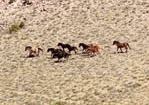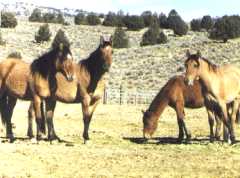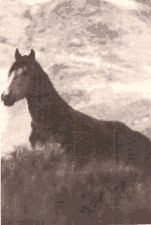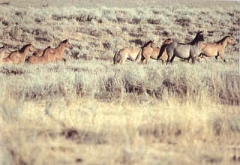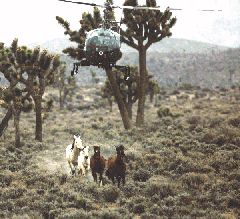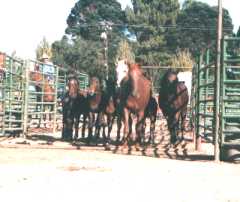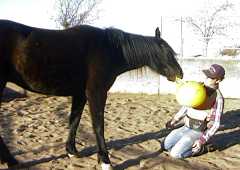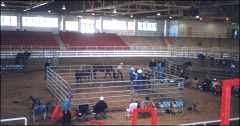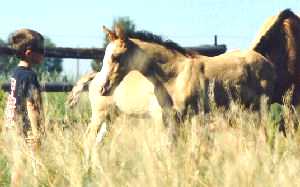Living on the range as we do, we understand that maintaining a healthy range is a balancing act. Few, if any ranges are as God or Mother Nature designed them to be. Man has introduced new plants and animals, and has killed off other plants and animals to the point that the ranges that exist today are a reflection of our presence, either past or present. Wild horses and burros are two components reintroduced by man, free for the most part of natural population controls such as cougars and wolves and, exceptionally capable of reproducing themselves to greater numbers. They present delicate issues with respect to how to maintain their presence in the western landscape yet still preserve harmonious balance with native plants and animals and other permitted activities on our public lands. Fifty years ago horse and burro populations were kept in check by hunters and mustangers. Today many wild horses and burros are protected by the Wild Free-Roaming Horse and Burro Act. But while the Act prevents protected animals from harassment, being shot and being captured and sold to the packers and rendering plants, it also recognizes the essential need for horses and burros to be managed in keeping with the overall needs of the lands where they range.
Congress appropriates specific funds for the BLM to manage the Wild Horse and Burro Program and BLM is expected to operate within its financial means.
Some folks will argue that repairing horse damage is part of the cost of doing business when leasing public rangelands. However the horses don't have any concept of boundary lines and during migrations or when overpopulated, they wander onto private property; some of this property being owned or leased by the same ranching interests that have to deal with the horses in areas leased from BLM. Therefore to preserve the relative freedom of a naturally wandering animal, the BLM has to try to seek the middle ground and maintain reasonable cooperation with ranchers regarding wild horse needs within BLM lands as well as adjacent private properties where the horses roam. One tactic used by some wild horse and burro groups is to attack the subsidized nature of Federal range grazing leases. Arguments against current grazing fees and the need to charge market value for grazing are constantly being presented. Folks on the other side of the argument will point out BLM is letting wild horse and burro enthusiasts purchase animals for as little as $125.00. These are animals that in some cases cost thousands to manage, gather, process and bring to adoption. So the subsidy issue isn't as clear-cut as it may seem.
Picture yourself in a an emotionally charged room full of people screaming, "Do more!" and "You're doing too much!" all at the same time. The bottom line is when BLM tries to take a reasonable middle ground position, a vast majority of the interest groups walk away upset that the BLM didn't provide more of what they wanted when perhaps they should take stock of the big picture and be more appreciative of what BLM is accomplishing. The grim reality is that there are people in Congress and elsewhere that are growing increasingly annoyed with wild horse and burro groups that can never seem to agree, that demand expensive solutions without consideration of where the money is coming from and that continually bash the agency that is trying to get the work done. More and more I'm hearing statements such as "Why are we spending this kind of money on these horses?" and "We're investing millions so that a few hundred horse enthusiasts can get cheap horses." (Of course the answer isn't that simple, either. Please see Wild Horse & Burro Economics.) There are increasing demands that the BLM get a better handle on its program costs. While many of us have successfully fought back some potentially horrendous cuts to the Wild Horse and Burro Program, Congress and influential fiscal conservatives are growing tired of an expensive program which in their eyes doesn't do much for the country in general, and which appears to them to be for a bunch of bickering people that can't even agree as to whether or not the program is any good. BLM oftentimes has to make some hard decisions, some where economic sense prevails over what we would prefer from the standpoint of benefitting a particular group of horses. Yet unless someone is prepared to come up with an endless supply of money, unpopular decisions will have to be made. So the issues we fight over shouldn't be whether BLM should do something that it can't possibly do due to impositions and constraints, but rather how we should cooperate, coordinate mitigation efforts and making the best of the cards that are being dealt by the people in Congress that control the funding.
Cruelty is yielding to the romantic notion that the horses should be allowed to roam free, unimpeded by man, to multiply at a rate of 17% or more until they stretch the limits of their environment. Then, and especially if weather conditions are unfavorable, they should slowly die in a frantic and desperate search for food and water, wiping out fragile plant communities, usually causing game and innocent native animals to suffer and die with them, and sometimes causing such environmental damage that it takes years for more fragile ranges to recover. What you often have in areas when the herds are not appropriately managed is not a humane approach to wildlife management, but simply "horse pollution." Gathering horses off the range is not a perfect science. Some horses get hurt. A few even die. However when left completely alone horses get hurt and die on the range, in some cases at a much higher rate than those few accidents that occur out of many thousands of horses gathered. Injury and mortality are part of the picture no matter where or how the horses are either managed or left alone. When one views the larger picture, overall horse mortality is much less and the horses' quality of life is much better when the herds are appropriately managed, and the current state of the art in herd management involves the gathering of excess horses. What constitutes cruelty is allowing horses to overpopulate, destroy the environment, destroy other plants and animals, then slowly starve to death. While we definitely would like to see improvements in areas of horse population control, and while we constantly fight for improved management techniques, safer gathers, more competent adopters and better program oversight, the worst possible option is to do nothing when the herds approach their practical upper population limits. What we're really dealing with when debating BLM policies and procedures is arguing the varied perspectives and opinions as to what are the best approaches to wild horse and burro management. Good ideas will be more likely heard, considered and implemented when they are not attached to accusations that if BLM doesn't agree, then it is an agency that is engaged in animal cruelty. Furthermore, Congress is more likely to fund some of the more reasonable ideas if the wild horse and burro groups can solidly unite behind the concepts that really make some sense. Also please remember that anyone can dream up a name for a wild horse group and throw up a web page. Some folks are careful about verifying their facts before presenting them, but we've seen a lot of very sensational claims made by others that never checked out. Some folks are sincere but misinformed or act on rumors. Others will say anything to get you to send them donations. If an individual or group presents what appears to be hysterical or exaggerated claims, contact us and we'll check the situation out through our contacts in the veteran mainstream WHB organizations.
These comments are not intended to be admonishments of the various wild horse and burro advocacy groups. I'm also not suggesting that we not address issues of less than critical concern. Through reasonable efforts we may cause improvements to occur in many needed areas. But we need to focus the bulk of our efforts and energy in areas where wild horses and burros are at the greatest risk. Critical issues that come to mind include:
Depending on many factors, spring gathers of wild horses can potentially cause increased risks to the animals gathered as compared with the hazards found in their natural environment. While gathering is an activity that has inherent risks, current statistics don't show proper gathers to pose much greater risk than the environment itself. A number of wild horse groups invest significant time and effort fighting with the BLM over the timing and methods of gathers to ensure the safety of the horses. Yet at the same time, wild horses and burros gathered by the National Park Service and US Fish and Wildlife Service often end up at the meat packers. In past years those horses held by the State of Nevada had 60 days to find homes or get dumped at the sale barn where they were sold by the pound, usually bid on by the killers. In comparing these situations, horses under NPS, FWS, state and local jurisdictions are at much greater risk than the BLM horses. While we would certainly want to maintain our position regarding reducing the risks of spring BLM gathers, we have to set priorities on how we commit our time and efforts. If we can't do both, then putting our greatest emphasis toward protecting the unprotected Nevada horses we would produce the greatest number of "saves."
"Zero adoption failures" is not a realistic concept, but that doesn't mean that we shouldn't strive toward such a goal, and in doing so establish levels of acceptable risk based on the same chances of injury and mortality as if the horses remained in the wild. If we did that, doesn't it then make sense to invest time volunteering to assist with compliance inspections and in adopter education so that this level of acceptable risk can be maintained?
Furthermore if efforts can be made to constructively engage other agencies and organizations and we spend our time working cooperatively rather than in conflict, we will have more time and resources left to invest in wild horses and burros, which after all is our stated mission, and we should see measurable improvements in the results that we obtain. Whether we succeed or fail is up to us. In the end there really is no one else to credit or blame. Willis Lamm
This is not a BLM operated or BLM sponsored site. It is run by private wild horse and burro enthusiasts and owners. Return to Wild Horse Issues and AnswersReturn to KBR Wild Horse and Burro NewsReturn to KBR World of Wild Horses & BurrosGo to other Wild Horse LinksGo To |
